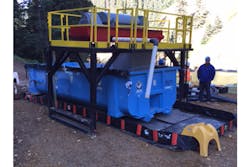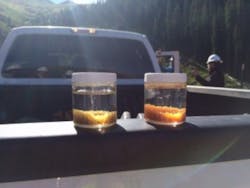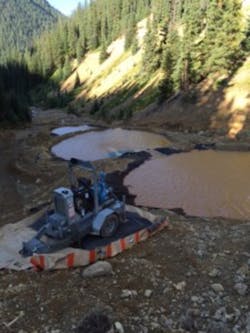By Julie Doris, Rain for Rent
The release of 3 million gallons of acidic water full of heavy metals required remediation, and required it quickly. In August 2015, the U.S. Environmental Protection Agency (EPA) contractors at the Gold King Mine in Colorado accidentally let the wastewater into the Colorado River system.
Almost immediately, communities and farms in Colorado, New Mexico and Utah were in danger from the arrival of water containing heavy metals such as cadmium, lead and other toxic elements such as arsenic. Water continuously flowed at 400 to 600 gallons per minute (gpm) after the initial breach from the mine. With a pH of 2 to 3, the water required an adjustment with lime prior to treatment with polymer to remove the solids and heavy metals.
To begin the cleanup effort, the EPA called on a company that provides emergency response site remediation, hazardous waste material management and removal services to act as the lead contractor on the project. This emergency response company contracted with another organization to provide an emergency treatment system, while a third company constructed an interim water treatment facility. All parties involved knew they had to manage the flow of the rivers while treating the contaminated water to mitigate additional contamination. The lead contractor involved a temporary liquid handling solutions company on two phases of the cleanup effort to move water so treatment could begin.
Samples taken from the river show high levels of heavy metals.
A treatment solution
Phase one of remediation required capturing water from the mouth of the mine at Upper Cement Creek into four settling ponds for initial emergency treatment to clarify and raise the system’s pH.
For the emergency water treatment system, a variety of equipment was utilized: two high head pumps, a roll off box, a hose, fittings, spill guards, traction mats and pipe support blocks. This equipment diverted water from the creek into the new system, which raised pH and removed solids into a roll off box before discharging clear water back into the river.
For phase two, a bypass moved water from the Gold King Mine into temporary weir ponds at the Red Bonita Mine (see Image 1). There the solids could begin to settle out before the water was sent back to Lower Cement Creek, and lime was added to the water to bring up the pH.
This part of the system used 3-inch pumps that work on flows up to 450 gpm and heads up to 320 feet in addition to 6-inch pumps, which are capable of flows up to 2,750 gpm and heads up to 195 feet. It also included about half a mile of 6-inch pipe and a combination of spillguards, hose and fittings to move the water to the Red Bonita Mine and then back to the Gold King Mine. A total of eight pumps provided a flow of approximately 1,200 gpm for the bypass.
Containment ponds were used to stop the contaminated water from seeping into the environment.
The biggest challenge of the water remediation effort was getting the flow from the Gold King Mine to the weir ponds at the Red Bonita Mine, which required pumping the water uphill. High head pumps that could handle the necessary head pressure and flow were needed. Accessing the remote site with multiple contractors on location made maneuvering to place equipment a challenge. Last, working at an altitude of nearly 12,000 feet made breathing in the thin air difficult for workers, but engineers recommended the right size pumps to offset any effects from the altitude.
The bypass performed successfully while the interim water treatment plant was installed. The managing company and the EPA were pleased with the pumps, bypass system and the team of employees on this project.
Irrigation need resolved
Meanwhile downriver, Navajo Nation growers and ranchers had no water. The Cudei irrigation canal was closed after tribal officials issued water-use restrictions. Once the river water was remediated, the tribe passed a resolution to lift the declaration of emergency, allowing river water to be released to growers. However, the Gadii’ahi-Tokoi Chapter House, along with two others, wanted to wait before resuming irrigation from the canal for its approximately 690 acres of melon, corn, vegetables, grain and hay.
Because a diversion was removed several years prior, the chapters needed a temporary system to pull water directly from the river. The Navajo Nation Division of Water Resources contacted the temporary liquid handling solutions company that worked on the primary Gold King Mine project to provide a pump and pipeline system.
Knowing they needed to act fast, the company sourced equipment and personnel from nearby branches to supply the emergency system in a few days. The project used two 12-inch pumps capable of moving 5,000 gpm through a half mile of two 12-inch pipes. The pumps and pipe for the irrigation water system were set up and operational in the short time frame given to install the system, and the chapter house said it was thankful to have water for its livestock and crops again.
Julie Doris is the corporate communications manager at Rain for Rent, a provider of temporary liquid handling solutions including pumps, tanks, filtration and spill containment. The company’s projects include flood relief, construction site dewatering, sewer bypasses and industrial plant turnarounds. Doris may be reached at [email protected].





